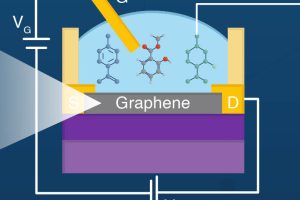Two advances that increase the life of perovskite cells were published in Science this week, both involving Ecole Polytechnique Fédérale de Lausanne (EPFL) and its solar cell guru Michael Grätzel (pictured). One of them was the discovery that promoting (111) crystal facets at the surface of perovskite thin films makes them more stable in the face of heat, light and ...
Research
The latest electronics research news from within the industry and universities from around the world.
Designer molecules turn graphene FETs into your custom electronic nose
Graphene FETs could make designer electronic noses, following research at Tokyo Tech. This kind of transistor has a channel made from the 2D material graphene, which has high electron mobility that can be modulated in various ways. The channel’s sensitivity to being gated by outside influences has led GFETs, as they are known, to be used in various types of ...
Government funds UK vehicle-to-everything energy transfer research
The UK Government has announced the companies that will be funded to develop vehicle-to-anything (V2X) energy transfer projects. Funded is via the Department for Business, Energy and Industrial Strategy (BEIS) and Innovate-UK. Malvern-based bi-directional EV charger company Indra is in two of the winning consortia: in Next Generation V2X Power Module to improve its charger, and in V2X Inflexion with ...
Georgia Tech shrinks the size of flow batteries
Sub-millimeter microtubular (hollow fibre) bundled membranes could shrink the size of flow battery reactors, according to the Georgia Institute of Technology. In a proof-of-concept zinc-iodide battery, the reactor part achieved 306.1W/litre discharge and charging at 1,322W/litre. Key to the concept is using tubes-within-tubes to make the reaction vessel into a self-supporting structure – doing away with the volume-consuming support hardware ...
Updated: Current-induced cooling shifts heat with ‘ionocaloric Stirling cycle’
Shunting ions around with electricity could produce enough heat transfer to replace greenhouse gas compression in domestic refrigerators, according to the US Lawrence Berkeley National Laboratory (LBL). The technology has been dubbed ‘ionocaloric cooling’. While warming and cooling a solid, liquid or gas can be used to shift some heat, much more can be shifted by a ‘phase change’ – ...
Molecular junction forms nano-scale thermoelectric harvester or thermometer
Molecular thermal energy harvesters or temperature sensors could be built from a particular organo-metallic material, according to scientists at the Tokyo Institute of Technology. “The team was curious as to whether multi-nuclear ruthenium alkynyl complexes based on multiple Ru(1,2-bis(diphenylphosphino)ethane)2 fragments could lead to more powerful molecular junctions, thanks to their unique electronic structure,” according to Tokyo Tech. Organo-metallic compounds with ...
Novel carbonaceous anodes prolong sodium ion battery life
Researchers from Korea and USA have developed an anode for sodium-ion batteries which can still store energy after 1,000 charge-discharge cycles, claims Pusan National University, which worked with the University of Illinois at Urbana Champaign. While sodium is cheaper than lithium, and sodium ion cells can theoretically store plenty of energy, potential electrode materials are not proving equal to the ...
Rallying cry from imec CEO
Imec CEO Luc Van den hove (pictured) has called for a renewal of the spirit of international cooperation which has driven the semiconductor industry’s extraordinary progress and could be harnessed to solve the world’s political challenges. “Throughout human history, working in unison and rallying our strengths has always paid off. It has allowed us to overcome challenge after challenge,” says ...
CES: Red micro-LED displays from AlInGaP aimed at AR glasses
Micledi Microdisplays has revealed red micro-LED demonstrators as CES today, using AlInGaP as a starting material. The spin-out from Belgian research lab Imec is aiming to make displays for augmented reality glasses, and is working on micro-LED displays in all three primary colours, including an alternative red display based on GaN. It also has proprietary micro-lenses that allow full-colour three-panel ...
NIST and AIM Photonics hook up on R&D
The U.S. Department of Commerce’s National Institute of Standards and Technology (NIST) has entered into an R&D cooperation research with AIM Photonics that will give chip developers a critical new tool for designing both opto and electrical iCs AIM Photonics, a Manufacturing USA institute, is a public-private partnership that accelerates the commercialisation of new technologies for manufacturing photonic chips. The ...
 Electronics Weekly Electronics Design & Components Tech News
Electronics Weekly Electronics Design & Components Tech News









